John and Mary Gardener were my 3rd great grand parents and the parents of Emma Jane Day (my 2nd great grand mother). John and Mary Gardener migrated from England to Australia in 1856 and moved to Mount Gambier in 1862.
All I knew before I started researching was that my 2nd great grand mother was born in India when her father was serving in the army.
The following is a collection of information I’ve learnt about my Gardener family history. It’s a combination of information of articles I found from my searches compared with information in Ross Henry Day’s “Albany Days: A Family History” book. I was able to access excerpts from Ross’s book in 2018 and his daughters Christine and Helen was lovely enough to send me a copy of his book in 2022.
This page is updated as I find new information and was last updated Nov 4, 2023.
Gardener Family Name
The Gardener family name spelling varied and is written as Gardener, Gardner and Gardiner on official documentations and in newspaper articles. These are common variants of the surname Gardner.
John Gardener father was a printer, bookseller and bookbinder and his mother was a dress and corset maker milliner in Hereford. All newspaper articles in the Hereford Times and Hereford Journal spell their name as Gardner.
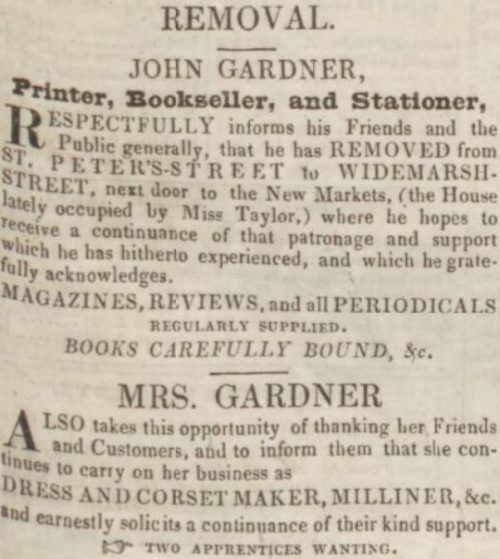
All three variants appear in John Gardener’s military records while Australian newspaper articles and on his gravestone spells his surname as Gardener.
Variations in official documentation were probably related to each clerk’s decision as to what the person considered the acceptable spelling of the name. The family probably decided once they have immigrated to Australia that it was easier for others to spell it as Gardener rather than keep correcting it to Gardner.
Variants of Gardener, Gardner and Gardiner were most likely used in our family history. Gardner was more likely the correct spelling of the family name in Hereford and it changed to Gardener when John and Mary migrated to Australia.
John Gardener
Emma Jane Day’s parent were John and Mary Gardener.
John Gardener’s parents were John Gardener and Ann Pritchard Phelps who married at Saint John Baptist in Hereford in 1817 and had the following children:
- John b 1820 d 1889 m Mary Mills b 1813 d 1897
- Eliza Harriet b 1822? m 30 Dec 1844 Charles Abbot Harris
- Robert Phelps b 1828 d 1830 – died when he was 2 years old
- William Phelps b 1830 d 1846
- Robert Phelps b 1832 d 1838 – given the same name as the son who died when he was 2. This son died when he was 5 from croup
- George b 1837 d 1837 – died when he was a baby
John Gardener was their oldest son who was born in the Parish of St Peters in 1820, in the town of Hereford in Herefordshire and was baptized on 21 Feb, 1820.

9th Lancers
At the age of 13 John was apprenticed to his father as a bookbinder whose original premise was on Widemarsh Street and later moved to Church Street, Hereford. John enlisted in the 17th Royal Lancers on February 6, 1841 when he was 20 years and 11 months. He listed his trade as a bookbinder when he enlisted and signed up for a bounty of three pounds nine shillings and sixpence. He was 6 feet tall with hazel eyes and dark brown hair.
He was assigned the regiment number 1166 and full designation in his pay book was:

He volunteered from the 17 Royal Lancers into the 9th Royal Lancers and served in the British army in India for ten years. While serving in India he married Mary Cousins, a widow with a daughter, and had four children.




His service record was:
- Enlisted in the 17th Lancers and held the rank of private from 6 Feb 1841 to 31 Mar 1842 for a period of 1 year and 54 days.
- Transferred from 17 Lancers to 9th Lancers on 1 April 1842 and served as a private with the 9th Lancers until 14 March, 1843 for 348 days.
- Promoted to rank of Corporal on 15 March, 1843 and held the rank of Corporal for 6 years and 351 days until 28 Feb, 1850.
- Reduced to the rank of Private on 1 March, 1850 and served until 30 Sept, 1852 for 2 years and 214 days.
- Further service from 1 Oct, 1852 until 13 September 1853 for 348 days.
He served in the following battles:
- Gwalior Campaign in 1843-4
- Present at the Battle of “Puniar” 29 Dec, 1843
- At the Sutledge Campaign in 1845-6
- Present at the Battle of “Sobraon” 10 February 1846
- Punjair Campaign in 1848-9
- Present at the ‘Chenab’ – 4 Dec, 1848
- Battle of Chillianwallah – 13 Jan, 1849
- Goojerat 1 Feb 1849
He received:
- Awarded the Punniar Star for action at Puniar in 1843
- Good conduct badge – 6 Feb 1846
- Chillianwallah Medal for his actions at the Battle of Chillianwallah and Gujerat in 1849
- Forfeited good conduct 24 Feb, 1850
- Restored good conduct 25 August, 1852
Photos of his medals from Ross Henry Day’s “Albany Days: A Family History” book.


The Indian Victories
Extracted from a letter of Corporal Gardiner, of 9th Lancers. to his relatives in Hereford and published in Hereford Times, 23 May 1846.
Head Quarters, Camp, Lahore,
March 10th 1846My dear family and friends – I gladly embrace the earliest moment of spare time I have had during this harrassing campaign, and employ it in writing, to let you know that I am still alive, and, through the Lord’s mercy, have escaped all the fatigues and dangers to with we have been exposed.
We commended our march on the 17th October 1845, and have been under canvas ever since, and as yet there is no prospect of our going back, at least this month or six weeks, – of course before this reaches old Hereford, you will have our full particulars of the five engagements our troops have nobly fought and won, – the first Moodkee; second Ferosha; thrid Allywallahl fourth, near the last mentioned place; fifth and decisive engagement, Sobraon; – here we attacked the enemy’s entrenchments, were repulsed twice, but ultimately gained the day, after a loss of our side of 256 killed and 2,076 wounded. We commenced firing at a quater before seven in the morning, and gained the entrenchments about one at noon. I had three very narrow escapes here; a twelve pound shot struck my horse dead, and before I was able to extricate myself from under his carcase a ball shot my sword away, and another cut my sword-belts and jacket from my side just above my hip; this was coming too warm to be agreeable; but although we were exposed to a heavy cross fire, we only lost seven horses killed on the spot and two shot afterwards; one man killed and one wounded, who is since dead.
My dear friends, our time is so fully taken up with in and our flying piquets, guards, escots, and parades, that I assure you when we have an hour off duty we are so exhausted that we are more fit for sleep than for anything else., therefore I hope you excuse this short scroll; but if I live to get back to my wife and children, then I promise you a long account of all our fatigues and privations.
I trust ere long you will receive my diary, which will contain nothing but the plain matters of fact – what I have gone through myself, and some of my brave comrades in arms, so that you may vouch for its accuracy. Although ours has been a much shorter campaign than expected, it has proved a most harrassing one, more especially on account of a want of water, that greatest of God’s blessings in this thirsty land. But, my dear friends, not withstanding all the privations we have suffered, we have gained five more lasting honours for our breasts and our colours; this has been a campaign that will be thought of for ages to come. What will the * * * * * say now? Will they say again that we have only been playing at soldiers in India? Why, our brave Commander-in-Chief did at Sobraon what **** never did; namely, attacked and defeated a superior force in an entrenched encampment, stormed and won it! Is not this immortal glory to Sir Hugh Gough, the hero of China, Gwallior and Sobraon? Yes, my friends, the British have gained themselves this glory, and God grant that all those who are spared may still live to wear their medals, and return to Old England, the heroes of the Punjaub!
Excuse this badly written letter, as I have a miserable pen, worse ink, and my desk is the top of my cap.
I remain your ever affectionate son and brother.
John Gardner.
Published in Hereford Times, 23 May 1846.
When he was discharged from army service his medical record said “as suffered from chronic hepatic inflammation and from intermittent fever for several years caused by the effects of climate only.”
The Principal medical office said that after examination on 10 August, 1853 at Chatham “I am of the opinion that John Gardener is in consequence of partial deafness and general impaired health unfit for further service”.
John was discharged from the 9th Lancers at Chatham on 13 September, 1853 at the age of 33 years.
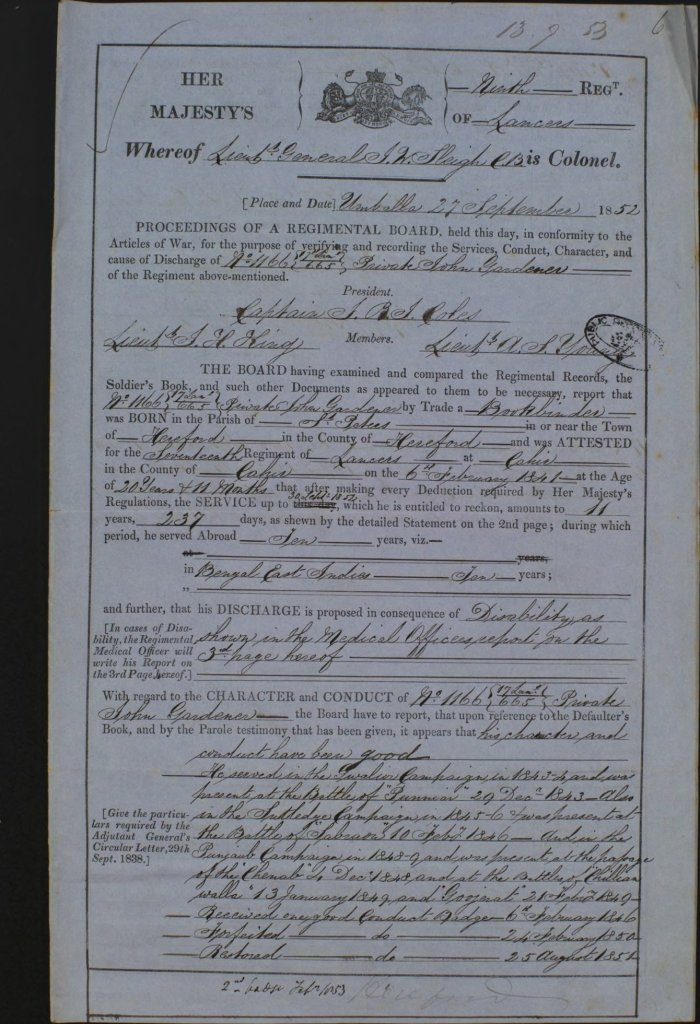



After discharge he was placed on a temporary pension.

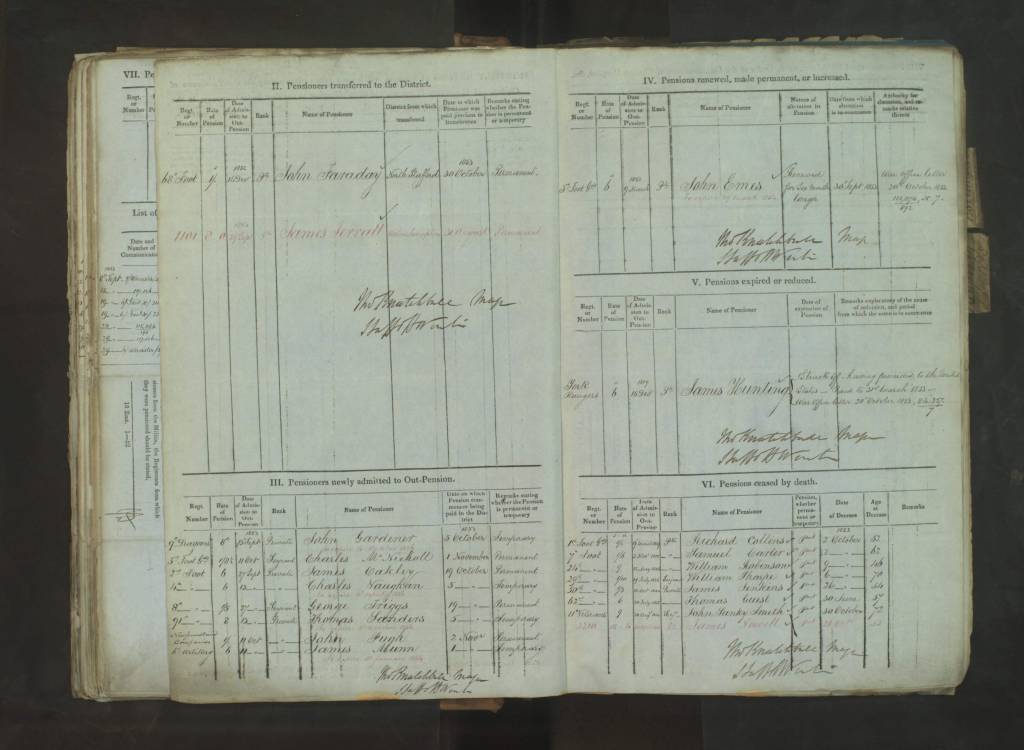

Jaeger Regiment of the British German Legion
After discharge from the 9th Lancers John, his wife Mary and children sailed back to England on 24 February, 1853. According to Ross Henry Day’s information in “Albany Days: A Family History” John Gardener transferred to the Hereford Militia as a paymaster clerk and was promoted to position of a quartermaster in the 3rd Jaeger Corps of the Jaeger Regiment of the British German Legion from 19 August, 1855 until May, 1856.
Marriage
John married Mary, a widower, in Cawnpore, Bengal, India on 10 Oct, 1844 when John was 24 and Mary was 27.
Below is a copy of their marriage records:


Below is a copy of the records of Mary’s first marriage.

Marriage announcement
Oct 11th at Cawnpore, East Indies, Corporal John Gardner, of the 9th Royal Lancers (eldest son of Mr Gardner, book-seller, of this city) to Mrs Cousins, late of New Bridge Street, Nottingham.
Hereford Times 11 January, 1845.
John and Mary had four children:
- Mary Maria – b 23 Sept, 1843 bp 21 Jan, 1844 (father William Cousins) d 28 Oct, 1928 age 86
- John James – b 2 Dec, 1845 d 13 Apr, 1846
- Emma Jane – b 7 Feb, 1848 in Meerut, Bengal, India bp 15 Mar, 1848
- Joseph Harris – b 13 Aug 1850 bp 28 Aug 1850 Wuzeerabad, Bengal, India d 5 July, 1924 age 73
- Eliza Ann b 5 Nov, 1852 Meerut, Bengal, India (Dame Roma Mitchell’s grandmother)
Migration to Australia
John and Mary Gardener migrated to Australia on the General Hewitt which left England on July 5, 1856 and arrived at Portland on Oct 9, 1856 with their son Joseph and their daughters Mary Maria and Eliza. Emma Jane remained behind in England presumably for her schooling and migrated on the Shackamaxon which left Liverpool on December 23, 1861 with 364 immigrants and arrived on March 16, 1862 into Melbourne, Victoria. You’ll find detailed information on General Hewitt voyage here
I’m assuming the family emigrated to Australia as part of the Victorian assisted migration program.
Below is the disposal list for John, Mary, Joseph and Eliza.
Below is the disposal list for Mary Maria.

Portland, Victoria
Based on the Disposal list from the General Hewitt John was bonded to work as a gardener for James Blair, who was Police Magistrate of Portland from 1840 until December, 1866. James Blair was a prominent early settler of Portland and held numerous positions in the community beside being Police Magistrate of Portland.
Mount Gambier
According to an article written about Mary Gardener’s death the family moved from Portland to Mount Gambier in 1862. I know he worked as a gardener for Dr E. Wehl in Mount Gambier. Dr E. Wehl was an early pioneer of Mount Gambier who tried several different businesses in addition to being the local doctor.

By 1864 he had purchased 9 acres of land from John Johnston to set up a nursery and was advertising as a nurseryman, seedsman and florist from March, 1864 until around June, 1866.

He started offering bookbinding service from October, 1868 until June, 1869.

John Gardener worked as the Secretary and Librarian for the Mount Gambier Institute.
The Mount Gambier Institute
John Gardener was employed at the Mount Gambier Institute in 1867 as the secretary, librarian as well as being responsible for preserving and stuffing specimens in the Institute’s museum and binding books. I’m assuming that he had been working as their librarian since about June, 1866 based on the date of last ad as a nurseryman, seedsman and florist.

The following history is summarized from a range of different sources including 1907 ‘THE MOUNT GAMBIER INSTITUTE.’, Border Watch (Mount Gambier, SA : 1861 – 1954), 3 August, p. 4. , viewed 30 Oct 2023, http://nla.gov.au/nla.news-article77557234
In July, 1862 Rev, Pitt Cobbett, an Episcopalian minister on his way from Adelaide to England, visited Mount Gambier and a lecture on the Late Prince Albert. At the end of the lecture he took the opportunity to suggest the importance of having a Literacy Institute in Mount Gambier. Mount Gambier was a town with about 800 people when the idea was proposed.
It was originally called the Mount Gambier Literacy Institute and the library was opened in Sept 4, 1862. Originally the library was housed in John MacDonald’s house and then moved to a temporary home adjoining the public school. After which it was moved to Mr A K Varley’s, a clerk of the Mount Gambier West Council, rooms in Evelyn St where it consisted of about 600 books. When Mr A K Varley’s became too small in 1866 they built a couple of weatherboard rooms to house the Institute.
John Gardener, who had been acting for some time as a librarian was appointed Secretary and Librarian for the Mount Gambier Institute in July, 1867 at £65 per year, with a commission of 5%, on other institute revenue, and was increased to £75 in 1868. Besides his normal duties he also preserved and stuffed specimens in the Institute’s museum and bound books.
The foundation stone for the new Mount Gambier Institute was laid on 8 Jan, 1868.

A new Mount Gambier Institute with a hall, library and reading room was started on Jan 6, 1868 with the laying of the foundation stone and the Institute transferred their library and business to the new building on June 28. The building wasn’t finished until 1869. In 1870 the Institute had 116 subscribers and 1,417 books.
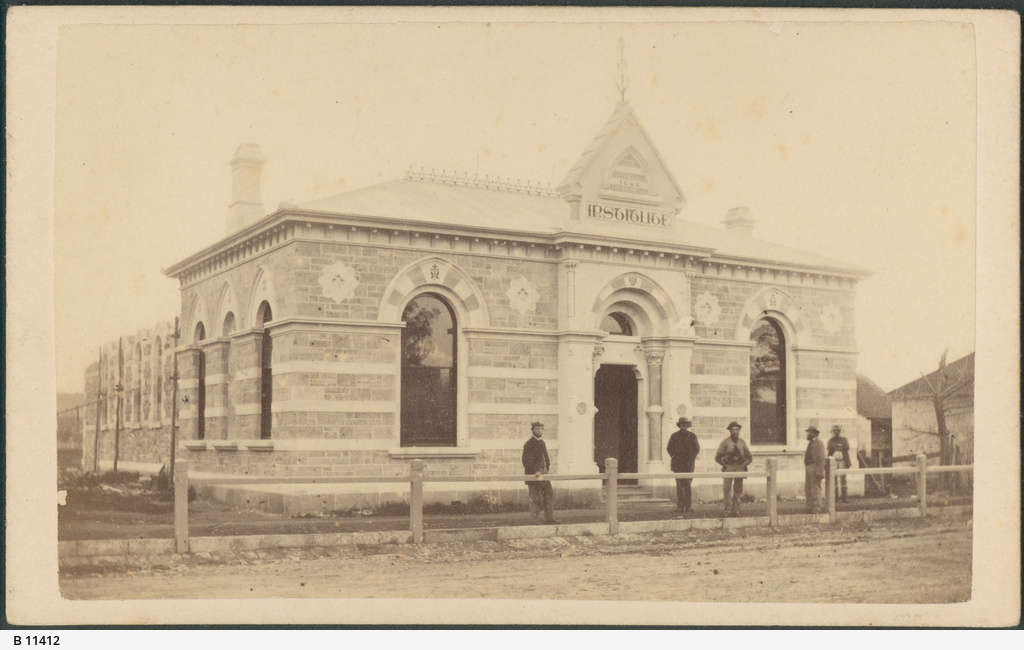
John Gardener’s Death
John Gardener died on 29 June,1869 when he was 49 as a result of an inflammation of the brain.
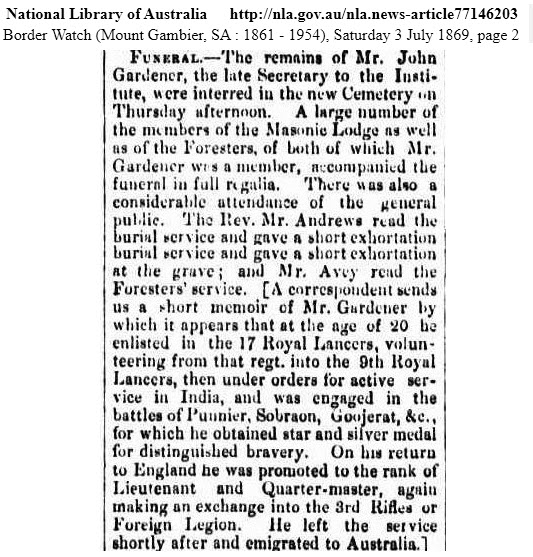
He was buried in the new Mount Gambier Cemetery (Lake Terrace Cemetery). His gravestone was commented on when the Town Council toured the cemetery as it lists him as the first librarian of the Mount Gambier Institute (Gravestone Image). As Cr. Truman comments in the article, John MacDonald was the first librarian of the Mount Gambier Institute. John Gardener was the first librarian of the new Mount Gambier Institute building.


Mary Gardener
I have found limited information on Mary Gardener and haven’t been able to confirm her date of birth. Her death notice from when she died in 1897 in Glenelg on 1 August states she was 84 (born in 1813). Her record of marriage from India states she was 27 when she married in 1844 (so would have been born in 1817).
She married William Cousins 3 Dec, 1838 in Radford in Nottingham and gave birth to their daughter Mary Maria Cousins on 20 Sept, 1843 in Bengal India. William Cousins died on May 3, 1844 in India when Mary Maria was 8 months old and Mary married John Gardener in Cawnpore, India on 10 October, 1844. She would have needed to remarry quickly otherwise she would have lost her small allowance 6 months after William’s death.
Only a small percentage of men were allowed to marry and those wives that were allowed to travel with their husbands were given a tiny allowance, lived in the barracks and earnt money for helping with tasks. It would have been a tough life raising children during the Sikh Wars moving over considerable distances.
John Gardener died in 1869 when he was 49 when Mary would have been about 52, Mary Maria was 26, Emma Jane was 21, Joseph Harris was 19 and Eliza Ann was 17. Mary Maria and Emma Jane were both married when John died. Joseph Harris and Eliza Ann were both probably still living at home. Eliza Ann married 5 years later.
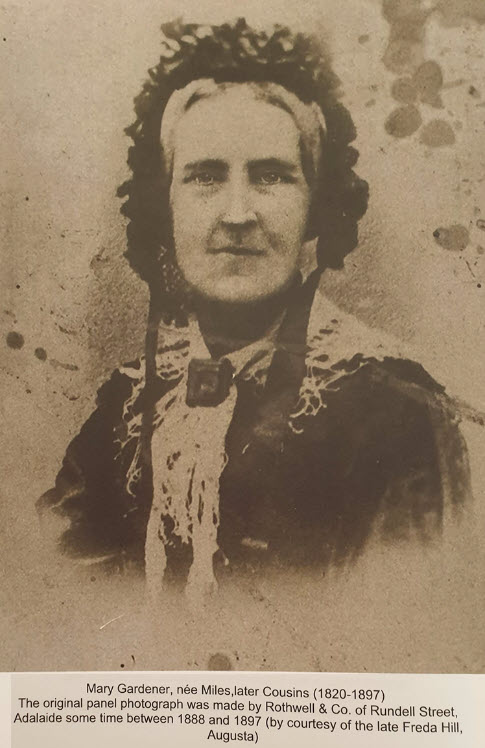
One of her death notices says she lived in Mount Gambier for over 30 years and moved some time ago to Glenelg to reside with her daughter. Mary died 30 years after John. She was still living in Mount Gambier in 1896 because her son Joseph Gardener had been charged with being a lunatic and attacking her.
Her health was reported to be feeble for many years and. Her death is reported to be at Aldephi-Terrace, Glenelg. This indicates she was residing with her youngest daughter, Eliza Ann who was married to Samuel James Mitchell. Samuel James Mitchell was granted to lease to Government Cottage Aldephi-Terrace, Glenelg in 1893 for 12 years.
Mary Maria Hartley
Mary Maria was Mary’s oldest child, the child of her first husband William Cousins, was born in India on 23 Sept, 1843. I’ve found limited information on Mary Maria.
Mary Maria married Edward Theodore Hartley on 15 Dec, 1862 when she was 19. They had 8 daughters and 1 son. Their son Charles died when he was 10 days old. Her husband Edward died on 8 May, 1915 when he was 71 and she was 72. She died on 28 Oct, 1928 aged 86.
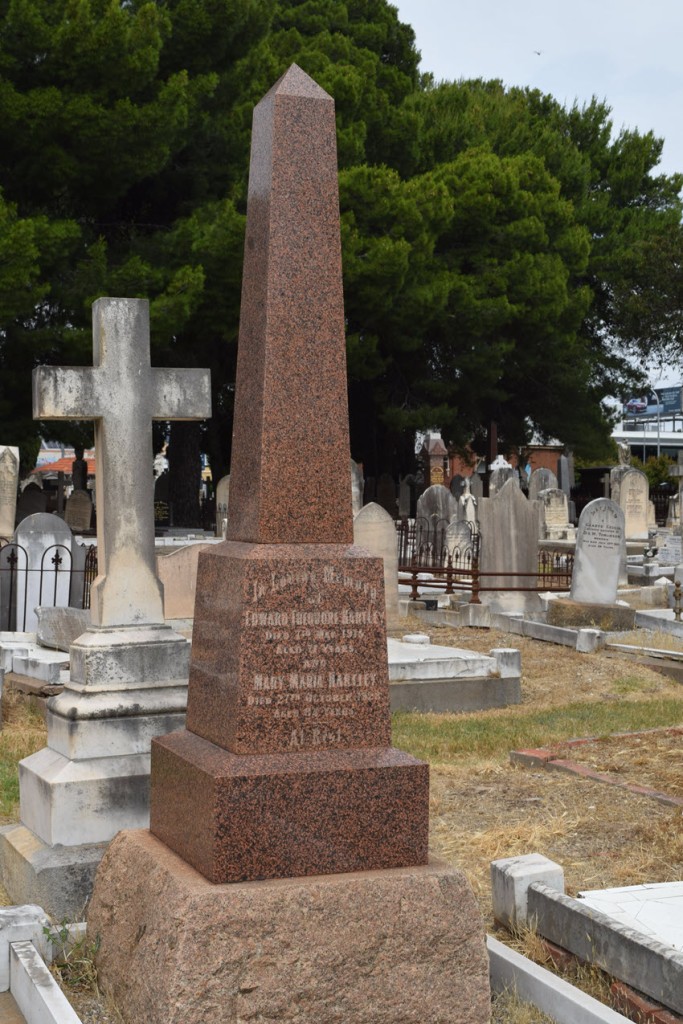
Emma Jane Day
Emma Jane Day was my great grandmother who was born on 7 Feb, 1848 in Meerut, Bengal, India. Refer to my Day Family history page to learn about her life.
Joseph Harris Gardener
Joseph Harris was born on 13 Aug 1850 in Wuzeerabad, Bengal, India and died on 5 July, 1924 aged 73.
In 1896 he was charged by police and eventually let off with a caution.
MOUNT GAMBIER POLICE COURT.
Friday, July 17 1896.
Joseph Gardiner was charged, on the information of Emma Jane Day, with being deemed to be a lunatic, and not under proper care and control. Emma Jane Day, widow, and sister of the accused, stated that he was subject to such uncontrollable bursts of ill-temper and ill treated his mother so much that she had been led to lay the information. He was always out at night, and used the vilest Language to anyone who came near the place, and she considered his brain was excited with insufficient sleep. He imagined all his relations ill-treated him, but they did not; they did all they could for him. He never did any work, but could get plenty if he liked to take it.
He had been under Dr. Jermyn for some time. When he was young he met with accident, which Dr. Jackson, who attended him at that time, had stated would lead to madness. To accused witness said it was not on his mother’s responsibility she had laid the information. Accused asked that his mother might be called to give evidence of what Dr. Jackson had stated.
Mary Maria Hartley, wife of Edward Hartley, stated that she was at present on a visit to her mother, Mrs. Gardiner, and that the accused was her half-brother. Last Wednesday night her mother went to take Joseph a cap of cocoa, but came back with it a few minutes after with accused following her. He went to go out, but his mother refused to let him, and he caught hold of her and gave her a good shaking. His mother still refused to let him out, and he pushed her back, and in falling she cut her head deeply. Accused then went out, but came book shortly after and denied having hurt his mother.
Since she had been there he had often come home at all hours of the night and made a great row, and on one occasion he had threatened to break her neck.
Mounted constable South deposed to having arrested the prisoner the previous afternoon on warrant. To accused he said he had known him good long time and had never noticed anything peculiar about him.
Frederick David Jermyn, medical practitioner, stated that he had been attending the accused and had always considered him a most eccentric individual. He had no delusions, but rambled about the street at night and suffered greatly from insomnia, which was a sign of insipient lunacy. He had not control of his temper, and he might have killed his mother by the way in which he had been told he threw her down.
Accused appeared to consider that his family were all against him, and he should say that he was not quite right in his mind. When in a state of melancholia he had been told that he had threatened to commit suicide, and he would advise his being committed for a time to see if it would do him good.
The accused asked that the case might be adjourned to allow of his being examined by the Assistant – Colonial Surgeon. At that time be would like to contradict some of the evidence of Dr. Jermyn; he had never threatened to commit suicide. In reply to Dr. Jermyn Constable South stated that on one occasion accused had told him that he was nearly putting his head on the rails once, but he had made no direct threat. The case was adjourned to 10 a.m. the following morning.
1896 ‘MOUNT GAMBIER POLICE COURT.’, Border Watch (Mount Gambier, SA : 1861 – 1954), 18 July, p. 2. , viewed 22 Jan 2017, http://nla.gov.au/nla.news-article77536633
Monday, July 20, 1896
Before Messrs. Ingleby and French, Justices.
Joseph Gardner, on remand, was brought forward. The accused asked to be allowed to give evidence in contradiction of the testimony of Mrs. Hartley and Dr. Jermyn, and being allowed denied that he assaulted his mother, although when she tried to push him out of the house he caught her by the hands.
He strongly denied Dr. Jermyn’s statement that he was subject to delusions, He worked when he could get it to do. He admitted wandering about at night. Dr. Johnson said he had examined the accused, and in his opinion he was not insane. He was a delicate man, and appeared to suffer from chronic infirmity and was troubled by insomnia and when intolerable in those conditions he went for walks at night and very early in the morning to pass the time. Through want of sleep and pain he thought his temper was made very irritable. He did not think it necessary to lock him up, and it would be no sense sending him to Adelaide, as he would be turned adrift again. If he assaulted his mother of course he should be punished like anybody else.
The information was dismissed, and the accused liberated with a caution.
Source:
1896 ‘MOUNT GAMBIER POLICE COURT.’, Border Watch (Mount Gambier, SA : 1861 – 1954), 22 July, p. 3. , viewed 24 Jan 2017, http://nla.gov.au/nla.news-article77536690
He did have an incident in 1874 when he was found unconscious and a follow up article said his mother claimed he had never had a fit previously.
1874 ‘EUROPEAN TELEGRAMS.’, Border Watch (Mount Gambier, SA : 1861 – 1954), 27 May, p. 2. , viewed 03 Nov 2023, http://nla.gov.au/nla.news-article77550954
ACCIDENT.-Yesterday morning a young man, named Joseph Gardener, was found in the country, a short distance from Mount Gambier, lying in a state of unconsciousness. He was immediately taken to the residence of his mother at Mount Gambier,” and subsequently to Hospital, where he is slowly recovering his usual state It is believed the sufferer must have been seized with a’ fit’ (he being occasionally” subject to fits)” whilst riding, and thus, have fallen off at the spot where found. The fall we. earn does not appear to have done him any injury and a speedy recovery is expected.
He was admitted to Mental Hospital Parkside on 3 June, 1924 and died in hospital on 4 July, 1924.

The information sent from Parkside Mental hospital to the police stated that when he was admitted he was suffering from dementia, his physical condition was very poor and was suffering from heart and kidney disease.

His post mortem confirmed he died from heart failure.

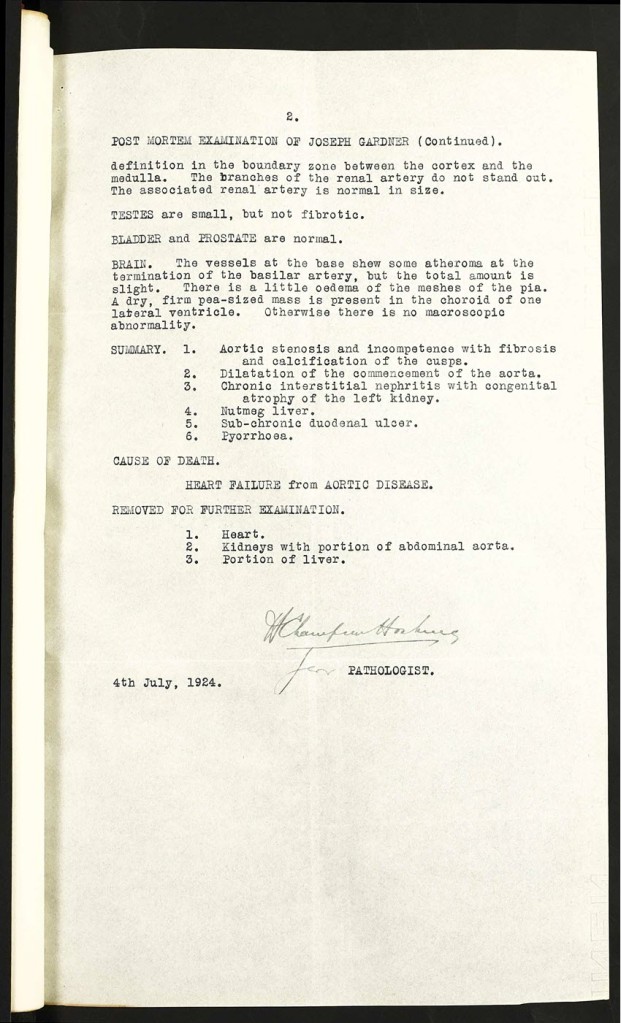

Eliza Ann Mitchell
Eliza Ann was John and Mary’s youngest child and she was born on 5 Nov, 1852 in Meerut, Bengal, India.
She married Samuel James Mitchell on 15 September 1875 when she was 22 years old and was the grandmother of Dame Roma Mitchell.

Samuel James Mitchell, barrister; his wife Eliza Ann, (nee Gardener) and their four children Edith Maud, Garnet Ethelbert, Harold Flinders (father of Dame Roma Mitchell) and Jean Hildegarde, Adelaide, 1899.
State Library of South Australia,PRG 778/23/1/5
Samuel James Mitchell was a politician and Judge:
- 1882-1883: Mayor of Port Augusta
- 1885: Worked as articles clerk.
- 1980: Graduated from University of Adelaide and admitted to the bar.
- 1901 – 1910: member of the South Australian House of Assembly representing the Northern Territory.
- 1909: Attorney-General of South Australia.
- 1910-1912: Government Resident of the Northern Territory and inaugural judge of the Supreme Court of the Northern Territory.
- 1912: Returned to South Australia worked in as a judge in various capacities until his death (Stipendiary Magistrate, first South Australian Judge of Insolvency 1918-1926, Stipendiary Magistrate of the Adelaide Local Court and Taxation Appeal Court.
Refer to 1926 ‘JUDGE MITCHELL’, The Register (Adelaide, SA : 1901 – 1929), 4 October, p. 11. , viewed 05 Nov 2023, http://nla.gov.au/nla.news-article54871350 for more information.
Dame Roma Mitchell
Eliza Ann and Samuel James Mitchell were the grandparents of Dame Roma Mitchell. Dame Roma Mitchell was the first woman to hold a number of positions in Australia:
- Woman’s Law Society – involved with some of her friends.
- 1935 – Admitted as a barrister.
- 1962 – First Australian woman to become a Queen’s Counsel.
- 1965 – member of the Council of the University of Adelaide and Australia’s first female Supreme Court judge.
- 1982 – appointed a Dame Commander of the British Empire.
- 1983 – the first woman outside the royal family to hold the chancellorship of a Commonwealth university.
- 1991 – made a Companion of the Order of Australia and became the first woman to be appointed a Governor in Australia when she was made Governor of South Australia.
- 2000 – Commander of the Royal Victorian Order.
Dame Roma Mitchell’s parents were Harold Flinders Mitchell, the third child and second son of Eliza Ann and Samuel James Mitchell, who married Maude Imelda Victoria Wickham. Harold and Maude had two daughter, Ruth (born 20 Jul 1910) and Roma (born 2 Oct 1913).
Harold Flinders Mitchell was a lawyer prior to enlisting in World War I on 1 July 1916 when Dame Roma Mitchell when she was almost 3 and he was killed in action at Dernancourt, France on 5 April 1918, aged 32 years when Roma was almost 5.


Her mother Maude felt strongly that a good education was the key for ensuring her daughters financial future so she ensured they both received a good education and she supported Roma’s ambition to become a lawyer. The family saw little of their grandparents from their fathers side and support for her career was from her mother’s side of the family. Her uncle Frank Villeneuve Smith who married her mother’s sister was a lawyer.
Excerpt from Dame Roma: Glimpses of a Glorious Life published in 2002.
“in the late nineteenth and early twentieth centuries, little overt or public antagonism between different forms of Christianity in Adelaide, but there was a good deal of hostility among evangelical Protestants to the doctrines and rituals of the Catholic religion (Romanism’), and a good deal of quiet discrimination against Catholics in some business firms and government departments.” Roma Mitchell recalled that when she was a child there was, to a substantial extent, distrust on the part of adherents to one Christian religion of the religious practices of other Christian religions’. After her young husband’s death, Roma’s mother was shy of her husband’s family, because they were Anglican and she was not, so the Mitchell daughters saw little of their distinguished grandfather.”
Except from Roma the first : a biography of Dame Roma Mitchell published 2007:
Harold’s distinguished Anglican father and mother seldom associated with their son’s Catholic widow: ‘my grandparents were bigoted as far as my mother was concerned” Dame Roma was to remark caustically.”
Dame Roma’s excerpts from Australian Biography: Dame Roma Mitchell in 1993.
Was your mother very religious?
Yes, she was. And in those days, of course, the religions were divided. It’s a joy to me today, especially in my present position, to see how ecumenical people are because my father, my mother’s family, was divided — her father’s side of the family were Anglicans, her mother’s Catholics and she was brought up as a Catholic. My father’s people were Anglicans and what we used to call ‘lay church’ in those days and it was, as far as they were concerned, it was a cause of division. They really didn’t like the Catholic religion at all in those days. My grandparents, I mean. Ah, so there were problems there, but she was deeply religious herself. And that was that.
So, one of the things that I was going to ask you was that your grandfather, whose career you ended up emulating at the Bar and then as a judge, was still alive for …
I was 13 when he died.
Did you see much of him?
I visited but not to get any great influence. He was a nice little man actually. He was very short and he was very nice. People liked him but I didn’t see enough of him to get any influence from him. I should suspect he would have been horrified if he’d known what I was going to do.
Oh really?
My grandmother lived, she lived long enough to see me in practice.
And was she pleased about that?
Ah, I think she was but she was a pretty unbending sort of a person. She had been born in India, her father was British Army in India, and she was typical.
Excerpts from Australian Biography: Dame Roma Mitchell.
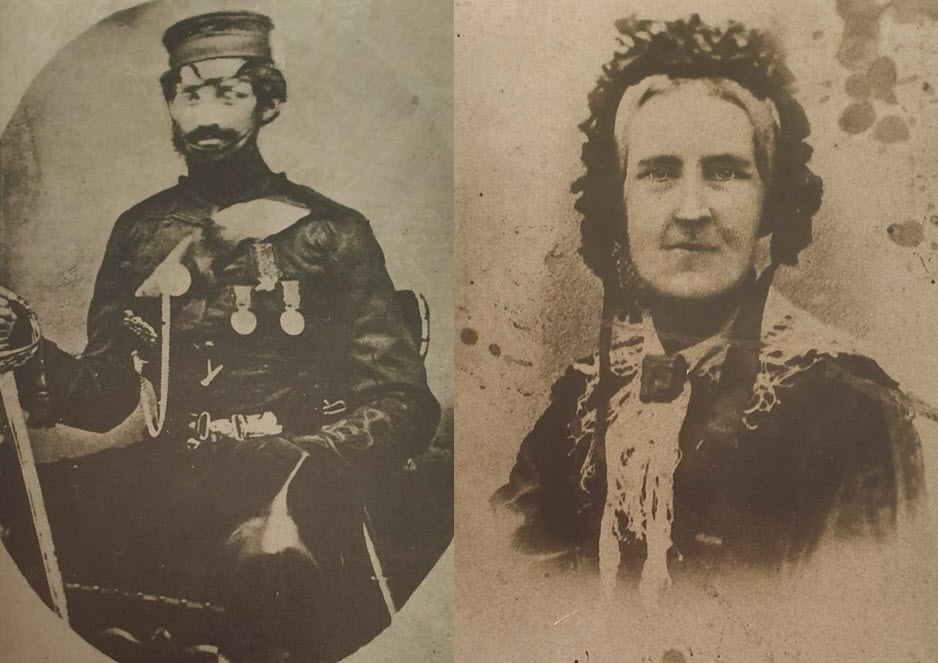



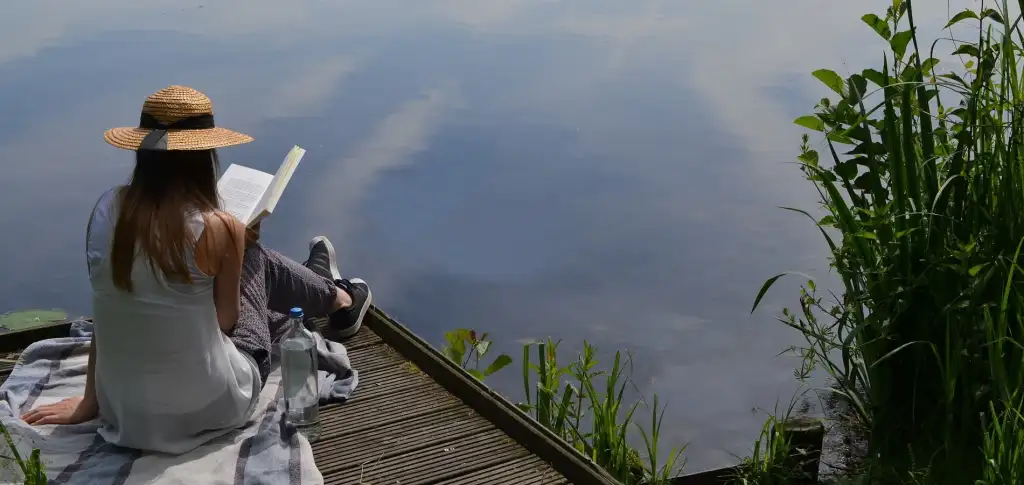

Leave a comment